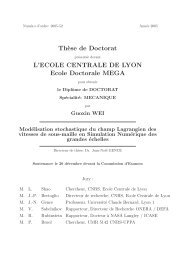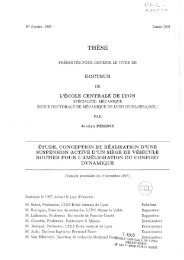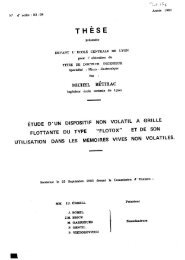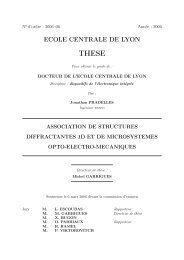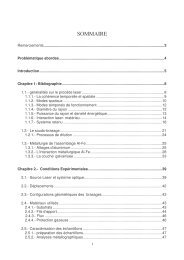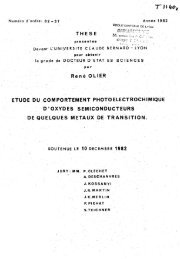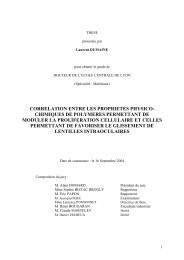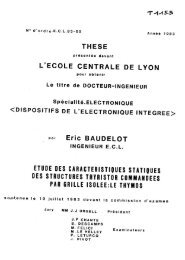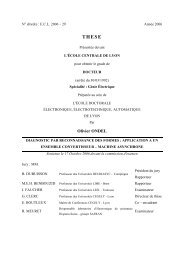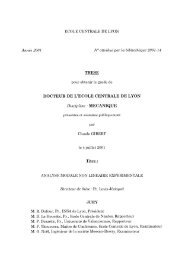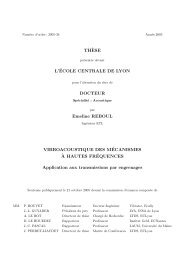Développement de capteurs à fibre optique basés sur la résonance ...
Développement de capteurs à fibre optique basés sur la résonance ...
Développement de capteurs à fibre optique basés sur la résonance ...
Create successful ePaper yourself
Turn your PDF publications into a flip-book with our unique Google optimized e-Paper software.
Article 2 Accepted by Sensor & Actuator A ( on 5 Nov., 1999, Reg. No. 99433)<br />
Earlier studies[3] have conclu<strong>de</strong>d that the light energy transmitted out of the fiber-optic is<br />
not affected by the po<strong>la</strong>rization of the inci<strong>de</strong>nt light. This phenomenon can be exp<strong>la</strong>ined by<br />
mo<strong>de</strong> mixing in multimo<strong>de</strong> optical fiber. The mo<strong>de</strong>ling based on geometric optics was then<br />
<strong>de</strong>veloped[4].<br />
We show in this paper the existence of the influences of the po<strong>la</strong>rization of the inci<strong>de</strong>nt<br />
light. Moreover, in certain conditions, these influences are important. We begin with the<br />
experimental results that <strong>de</strong>monstrate the apparent differences of the normalized light power<br />
transmitted out of the fiber between the illuminations of p- and s- po<strong>la</strong>rized light. The<br />
mea<strong>sur</strong>ed fiber is only 10cm long that is applicable to the future portable <strong>de</strong>vice. A 3D mo<strong>de</strong>l<br />
that resolves the electric field into p- and s- components during the light propagation has been<br />
<strong>de</strong>veloped. The computations agree well with the experiments. The next part of this paper is<br />
<strong>de</strong>voted to investigate the influences of the p- and s- po<strong>la</strong>rized inci<strong>de</strong>nt light to the transmitted<br />
light power and the sensitivity of the sensor. The conditions at which this 3D mo<strong>de</strong>l has to be<br />
used are conclu<strong>de</strong>d. The validity and limit of the earlier conclusions[3 are c<strong>la</strong>rified.<br />
2. Experiments<br />
Fig,1, Schematic representation of the fiber-optic sensor<br />
The fiber optic used in our experiments was the multimo<strong>de</strong> step-in<strong>de</strong>x silica/silicone<br />
optical fiber (Quartz et Silice PCS 600). A total length of 100mm fiber was cut and its two<br />
ends were carefully polished to minimize the scattering of light. A section of c<strong>la</strong>dding from<br />
4mm to 19mm was removed by mechanical and chemical methods[1-3]. Then a gold film of<br />
55nm thick, monitored by a quartz-crystal <strong>de</strong>tector, was <strong>de</strong>posited on this section via thermal<br />
evaporation. After 2 days for stabilization of the metal film exposed to air at room<br />
temperature, the fiber (see figure 1) was mounted through a small cell which contained the<br />
tested solutions with certain indices monitored by an Abbe refractometer. The mixture of<br />
27



